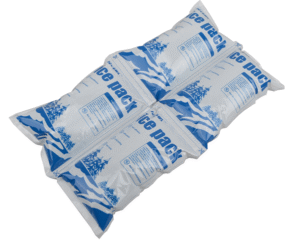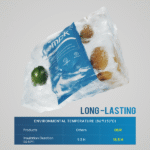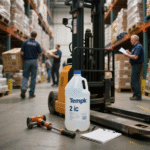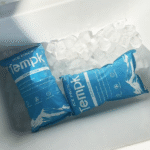Trockeneisbeläge: Wie man wählt, Größe & Schiff in 2025
Wenn Sie verderbliche Sachen versenden, dry ice pads can keep food safe or frozen when used correctly—and compliant labeling matters when real dry ice (Solid Co₂) is involved. Start with simple rules: planen 5–10 lb of dry ice per 24 Std. for deep-frozen lanes and keep chilled foods ≤ 40 ° F. (4°C) end-to-end. For passenger travel, dry ice is limited to 2.5 kg pro Paket. Aktualisiert: August 18, 2025.
-
Pick the right dry ice pads type for chilled vs. gefrorene Gassen (long-tail: dry ice pads for shipping food).
-
Calculate how many dry ice pads or pounds of dry ice you need for 24–72 hours (long-tail: how many dry ice pads do I need).
-
Pack and label UN1845 dry ice correctly in 2025 to avoid rejections (long-tail: Try -Eis -Versandregeln 2025).
-
Verwenden PCM pads and gel packs to skip hazmat when deep-freeze isn’t required.
What are dry ice pads—and which type do you need?
Kurze Antwort: Dry ice pads can mean two things. Insulated dry ice pads are fabric covers used with real dry ice to slow sublimation. Reusable “dry-ice‑style pads” are polymer/PCM sheets you hydrate or freeze; they are nicht CO₂ and suit chilled or moderate frozen ranges. Use real dry ice for ultracold (–78,5 ° C.) and use pads/PCM for 2–8°C or −10°C to −20°C targets.
Warum ist es wichtig: Real dry ice requires vented packaging and UN1845 Markierungen; reusable pads/PCM don’t release gas and avoid hazmat paperwork, making handoffs simpler for many food lanes.
When should you choose PCM “dry ice pads” vs. Echtes Trockeneis?
Für −20°C frozen but not ultracold: pick PCM pads (Z.B., 5°F/−15°C setpoints) to stabilize loads without CO₂ handling. Für ultracold or hard-frozen (Eiscreme, long-haul meats), wählen Echtes Trockeneis and vent the shipper. So oder so, pre-chill products and fill voids to slow heat gain.
| Pad / Refrigerant Type | What it is | Typische Temperaturbande | Was es für Sie bedeutet |
|---|---|---|---|
| Insulated dry ice pad (cover) | Fabric/insulated topper used mit Trockeneis | Works with −78.5°C | Reduces sublimation during frequent access; not a coolant by itself. |
| Hydrated “dry-ice‑style” pad sheet | Polymer cells you wet/freeze | ~10–32°F (−12–0°C) | Great for 2–8°C chilled; einfach, non‑hazmat; flexible fit. |
| PCM panel (~5°F/−15°C) | Fixed‑setpoint phase‑change pack | ~5–20°F (−15–−6°C) | Bridges chilled–frozen gap; more stable than gel; no CO₂ gas. |
| Trockeneis (Co₂, UN1845) | Solid carbon dioxide | –78,5 ° C. (–109,3 ° F.) | Best for ultracold; requires venting + Beschriftung; plan mass carefully. |
Practical tips for you
-
Frequent access? Add an insulated dry ice pad over dry ice between picks to slow loss.
-
Chilled lanes (≤ 40 ° F.): Verwenden dry ice pads (sheets/gel) and pack tight; add a 5°F PCM if ambient is hot.
-
Gefroren (−20°C) without hazmat: Verwenden PCM pads around the payload for a flat cold plateau.
Wirklicher Fall: A cheesecake brand compared six “dry‑ice‑style” pads + two PCM panels vs. 12 lb dry ice in a 30‑qt shipper over 30 Std.. Pads/PCM held 34–38°F with zero leaks; dry ice kept rock‑solid frozen—ideal for hard‑frozen SKUs.
How many dry ice pads—or pounds of dry ice—do you need?
Planning rules you can trust: Für gekühlt Gassen, Beginnen Sie mit ≈1 lb of pad/gel per cubic foot per 24 H; scale up 25–50% for hot routes or thin insulation. Für deep‑frozen, planen 5–10 lb of dry ice per 24 H per well‑insulated box. Validate with a small test and a logger before you scale.
Schneller Schätzer (kopieren/einfügen):
| Container Size | Dry ice pads für 24 H (gekühlt) | Trockeneis für 24 H (gefroren) | Was bedeutet dies für Sie |
|---|---|---|---|
| 25‑qt shipper | 2–3 hydrated pad sheets + 1 PCM panel | ~10–15 lb | Pads hit 33–40°F; use dry ice for hard‑frozen outcomes. |
| 45‑qt shipper | 4–5 pad sheets + 2 PCM panels | ~15–20 lb | Layer top & bottom for uniform temps. |
| 60‑qt shipper | 6 pad sheets + 2–3 PCM panels | ~18–25 lb | Fill voids and pre‑chill cargo to slow heat gain. |
Field‑tested sizing cues
-
Hot route or long transit? Hinzufügen 25–50% coolant and consider PCM to smooth swings.
-
Benchmark: A 25‑qt cooler typically needs ~10–15 lb/day of dry ice for frozen results.
How to pack with dry ice pads (and with dry ice) for safe delivery?
Chilled with pads/PCM/gel (Kein Hazmat):
Vorschreibe product ≤40°F; line bottom with pads; flank with PCM on the sides; top with gel; Hohlräume füllen; fully Siegel (no vent needed for pads/gel).
Frozen with dry ice (Heimat):
Freeze solid, Ort Trockeneis oben (Kaltes Waschbecken), vent package, Und markieren: "Trockeneis" oder "Kohlendioxid", solide,” UN1845, net dry‑ice weight (kg), Plus Klasse 9 Etikett. Folgen Sie dem 2025 Akzeptanz -Checkliste.
Beschriftung & 2025 compliance made simple (UN1845)
-
Entlüftung: Never airtight—allow CO₂ to escape to avoid rupture.
-
Markierungen: Richtiger Versandname, UN1845, Netz kg, Versender/Empfänger, Klasse 9 Diamant.
-
Air travel: 2.5 kg dry ice per passenger package, Genehmigung der Fluggesellschaft erforderlich.
-
Postal/Express: USPS air ≤5 lb; FedEx/UPS mirror IATA/49 CFR for packaging & Markierungen.
Kopieren Sie den Textext (example):
Pro tips that prevent warm arrivals
-
Voraussetzung: Freeze PCM/gel 24–36 h; pre‑chill boxes.
-
Platzierung: Trockeneis oben; pads unten + Spitze; minimieren Sie den Kopfspace.
-
Validierung: Drop a mini temperature logger in pilot boxes; standardize SOPs by lane.
Case in one line: With six pad sheets + two PCM panels, a 30‑hour lane held 34–38°F and avoided DG fees, while the same box with 12 LB Trockeneis arrived frozen solid. Choose per SKU and promise.
2025 trends in dry ice pads & cold chain—what changed?
Snapshot: Der 2025 Hier ist DGR (66th ed.) and carrier checklists formalize UN1845 weight/marking clarity; PCM adoption grows as brands seek non‑DG stability for −20°C runs; VIP liners and better insulation reduce required coolant mass. Expect hybrid packs: PCM dry ice pads around the payload, mit a smaller dry‑ice topper for margin.
Neueste Fortschritte auf einen Blick
-
Checklist clarity: Fewer acceptance rejections when UN1845 and net kg are on the same panel.
-
−20°C PCM maturity: More vendors, better hold times, simpler reconditioning.
-
CO₂ supply dynamics: Mixed strategies hedge price/availability risk with PCM hybrids.
Market insight: As insulation improves (Z.B., VIP liners), you’ll often ship the same payload with fewer pads or less dry ice, trimming freight and DG fees without sacrificing temperature.
Häufig gestellte Fragen
1) Are dry ice pads the same as dry ice?
NEIN. Insulated pads cover real dry ice to slow loss; reusable “dry‑ice‑style” pads are Gel/PCM and suit chilled/moderate frozen—nicht ultracold −78.5°C.
2) Wie viel Trockeneis pro Tag sollte ich planen?
Beginnen Sie mit 5–10 lb per 24 H in a quality shipper; add 20–30% for summer lanes; verify with a test.
3) Do PCM “dry ice pads” need hazmat labels?
NEIN. PCM pads don’t release CO₂ gas and don’t require Class 9 labels—still validate duration.
4) Kann ich mit Trockeneis fliegen??
Yes—up to 2.5 kg per passenger package in a entlüftet container with airline approval and proper marks.
5) What food safety target should I follow for chilled shipments?
Keep foods ≤ 40 ° F. (4°C) from packout through delivery; log pilot runs to confirm.
Zusammenfassung & Nächste Schritte
Schlüsselpunkte: Verwenden dry ice pads (pads/gel/PCM) for chilled or −20°C lanes; wählen Trockeneis for ultracold, Und Entlüftung + Label UN1845 correctly. Planen 1 lb/ft³/24 h for pads/gel and 5–10 lb/24 h für Trockeneis, then validate with a logger. Keep food ≤ 40 ° F. across the journey.
Aktionsplan:
-
Set your temperature goal (gekühlt vs. gefroren).
-
Wählen Sie das Kühlmittel: pads/PCM for chilled/−20°C; dry ice for ultracold.
-
Verwenden Sie den Schätzer oben; add a summer buffer.
-
Print labels (Wenn Sie Trockeneis verwenden) und folge dem 2025 Checkliste.
-
Run a lane pilot, review data, then codify your SOP.
60‑Second Coolant Picker (interactive checklist)
-
I need Ultrakold (≤−70°C) → Trockeneis + insulated pad cover; UN1845 label; entlüftet.
-
I need gefroren (−20°C) → PCM “dry ice pads” around payload; avoid DG paperwork.
-
I need gekühlt (2–8 ° C) → Hydrated pad sheets/gel; full coverage; minimal headspace.
Über Tempk
We design cold‑chain systems that meet your exact temperature and duration at the lowest total landed cost. Our engineers benchmark dry ice pads, Gel, PCM, und Isolierung against your lanes, then deliver clear SOPs, safety notes, and label templates—validated with data loggers.
CTA: Want a free one‑lane packout template or sizing check? Sprechen Sie mit einem Tempk -Spezialisten Heute.
























